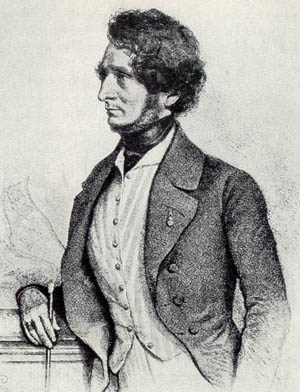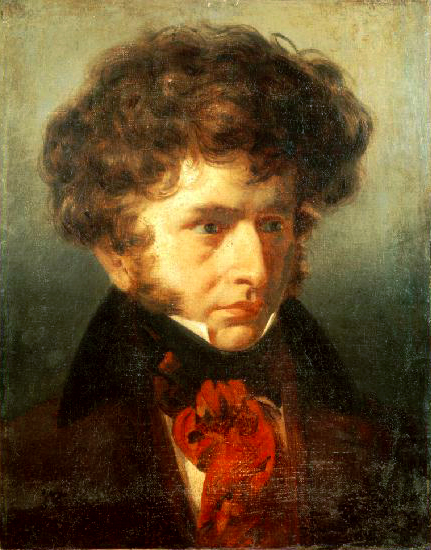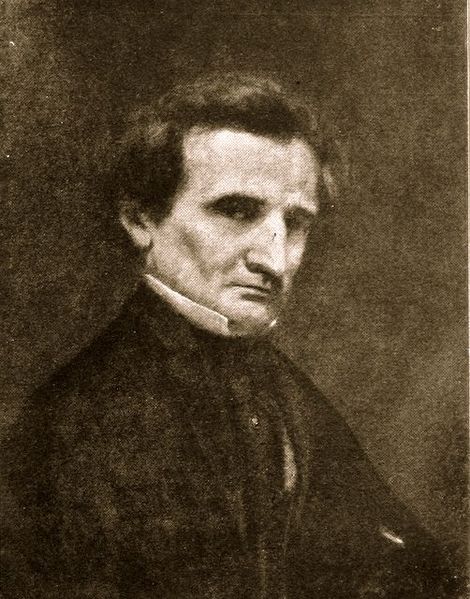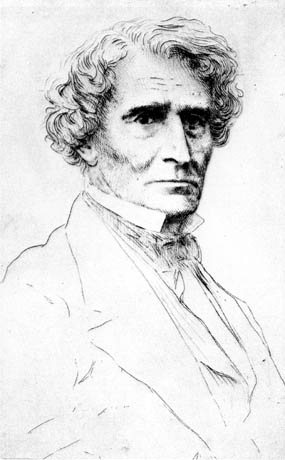<Back to Index>
- Physicist Max Born, 1882
- Composer Hector Berlioz, 1803
- Mayor of New York City Fiorello Enrico La Guardia, 1882
PAGE SPONSOR
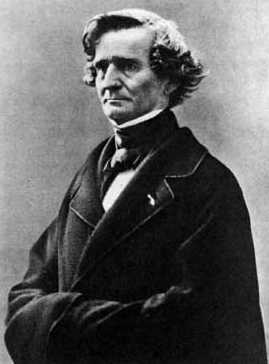
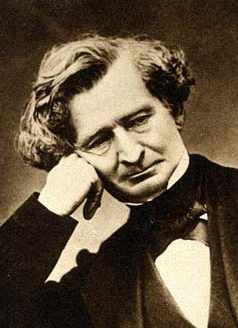
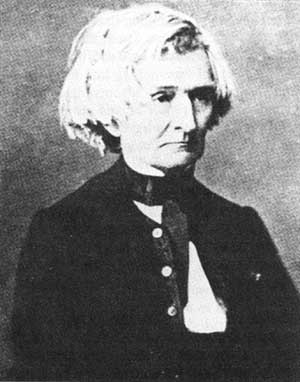
Hector Berlioz (December 11, 1803 – March 8, 1869) was a French Romantic composer, best known for his compositions Symphonie fantastique and Grande messe des morts (Requiem). Berlioz made significant contributions to the modern orchestra with his Treatise on Instrumentation. He specified huge orchestral forces for some of his works; as a conductor, he performed several concerts with more than 1,000 musicians. He also composed around 50 songs.
Hector Berlioz was born in France at La Côte-Saint-André in the département of Isère, near Lyon. His father, a respected provincial physician and scholar, was responsible for much of the young Berlioz's education. His father was an atheist, with a liberal outlook; his mother was an orthodox Roman Catholic. He had five siblings in all, three of whom did not survive to adulthood. The other two, Nanci and Adèle, remained close to Berlioz throughout his life. Unlike many other composers of the time, Berlioz was not a child prodigy;
he began studying music at age 12, when he began writing small
compositions and arrangements. As a result of his father's
discouragement, he never learned to play the piano, a peculiarity he
later described as both beneficial and detrimental. He became proficient at guitar, flageolet, and flute. He learned harmony by textbooks alone — he was not formally trained. The majority of his early compositions were romances and chamber pieces. Still at age 12, as recalled in his Mémoires, he experienced his first passion for a woman, an 18 year old next door neighbour named Estelle Fornier (née Dubœuf). Berlioz appears to have been innately Romantic, this characteristic manifesting itself in his love affairs, adoration of great romantic literature, and his weeping at passages by Virgil (by age twelve he had learned to read Virgil in Latin and translate it into French under his father's tutelage), Shakespeare, and Beethoven. In 1821, at age 18, Berlioz was sent to Paris to study medicine, a field for which he had no interest and, later, outright disgust after viewing a human corpse being dissected. (He gives a colorful account in his Mémoires.) He began to take advantage of the institutions he now had access to in the city, including his first visit to the Paris Opéra, where he saw Iphigénie en Tauride by Christoph Willibald Gluck, a composer whom he came to admire above all, jointly alongside Ludwig van Beethoven. He also began to visit the Paris Conservatoire library, seeking out scores of Gluck's operas and making personal copies of parts of them. He recalled in his Mémoires his first encounter with Luigi Cherubini,
the Conservatoire's then music director. Cherubini attempted to throw
the impetuous Berlioz out of the library since he was not a formal
music student at that time. Berlioz also heard two operas by Gaspare Spontini,
a composer who influenced him through their friendship, and whom he
later championed when working as a critic. From then on, he devoted
himself to composition. He was encouraged in his endeavors by Jean-François Le Sueur, director of the Royal Chapel and professor at the Conservatoire. In 1823, he wrote his first article — a letter to the journal Le corsaire defending Spontini's La vestale. By now he had composed several works including Estelle et Némorin and Le passage de la mer Rouge (The
Crossing of the Red Sea) - both now lost - the latter of which
convinced Lesueur to take Berlioz on as one of his private pupils. Despite his parents' disapproval, in 1824 he formally abandoned his medical studies to pursue a career in music. He composed the Messe solennelle.
This work was rehearsed and revised after the rehearsal but not
performed until the following year. Berlioz later claimed to have burnt
the score, but it was miraculously re-discovered in 1991. Later that year or in 1825, he began to compose the opera Les francs-juges, which was completed the following year but went unperformed. The work survives only in fragments; the overture survives and is sometimes played in concert. In 1826 he began attending the Conservatoire to study composition under Le Sueur and Anton Reicha. He also submitted a fugue to the Prix de Rome, but was eliminated in the primary round. Winning the prize would become an obsession until he finally won it in 1830, with his new cantata every
year until he succeeded at his fourth attempt. The reason for this
interest in the prize was not just academic recognition. The prize
included a five year pension - much needed income for the struggling composer. In 1827 he composed the Waverly overture after Walter Scott's Waverley novels. He also began working as a chorus singer at a vaudeville theatre to contribute towards an income. Later that year, he saw his future wife Harriet Smithson at the Odéon theatre playing Ophelia in Hamlet and Juliet in Romeo and Juliet, both plays by William Shakespeare. He immediately became infatuated by both actress and playwright. From
then on, he began to send Harriet messages, but she considered
Berlioz's letters introducing himself to her so overly passionate that
she refused his advances. In 1828 Berlioz heard Beethoven's third and fifth symphonies performed at the Paris Conservatoire - an experience that he found overwhelming. He also read Johann Wolfgang von Goethe's Faust for the first time (in French translation), which would become the inspiration for Huit scènes de Faust (his Opus 1), much later re-developed as La damnation de Faust. He also came into contact with Beethoven's string quartets and piano sonatas,
and recognised the importance of these immediately. He began to study
English so that he could read Shakespeare. Around the same time, he
also began to write musical criticism. He began and finished composition of the Symphonie fantastique in
1830, a work which would bring Berlioz much fame and notoriety. He
entered into a relationship with - and subsequently became engaged to -
Camille Moke, despite the symphony being inspired by Berlioz's
obsession with Harriet Smithson. As his fourth cantata for submittal to the Prix de Rome neared completion, the July Revolution broke out. "I was finishing my cantata when the revolution broke out", he recorded in his Mémoires,
"I dashed off the final pages of my orchestral score to the sound of
stray bullets coming over the roofs and pattering on the wall outside
my window. On the 29th I had finished, and was free to go out and roam
about Paris 'till morning, pistol in hand". Shortly later, he finally won the prize with the cantata Sardanapale. He also arranged the French national anthem La Marseillaise and composed an overture to Shakespeare's The Tempest, which was the first of his pieces to play at the Paris Opéra, but an hour before the performance began, quite ironically, a sudden storm created the worst rain in Paris for 50 years, meaning the performance was almost deserted. Berlioz met Franz Liszt who
was also attending the concert. This proved to be the beginning of a
long friendship. Liszt would later transcribe the entire Symphonie fantastique for piano to enable more people to hear it. On December 30, 1831, Berlioz left France for Rome, prompted by a clause in the Prix de Rome which
required winners to spend two years studying there. Although none of
his major works were actually written in Italy, his travels and
experiences there would later influence and inspire much of his music.
This is most evident in the thematic aspects of his music, particularly Harold en Italie (1834), a work inspired by Byron's Childe Harold.
Berlioz later recalled that his, "intention was to write a series of
orchestral scenes, in which the solo viola would be involved as a more
or less active participant [with the orchestra] while retaining its own
character. By placing it among the poetic memories formed from my
wanderings in Abruzzi, I wanted to make the viola a kind of melancholy dreamer in the manner of Byron's Childe-Harold." While in Rome, he stayed at the French Academy in the Villa Medici.
He found the city distasteful, writing, "Rome is the most stupid and
prosaic city I know; it is no place for anyone with head or heart." He
therefore made an effort to leave the city as often as possible, making
frequent trips to the surrounding country. During one of these trips,
while Berlioz enjoyed an afternoon of sailing, he encountered a group of Carbonari. These were members of a secret society of Italian patriots based in France with the aim of creating a unified Italy. During
his stay in Italy, he received a letter from the mother of his
fiancée informing him that she had called off their engagement. Instead her daughter was to marry Camille Pleyel (son of Ignaz Pleyel),
a rich piano manufacturer. Enraged, Berlioz decided to return to Paris
and take revenge on Pleyel, his fiancée, and her mother by
killing all three of them. He created an elaborate plan, going so far
as to purchase a dress, wig and hat with a veil (with which he was to
disguise himself as a woman in order to gain entry to their home). He even stole a pair of double-barrelled pistols from the Academy to kill them with, saving a single shot for himself. Meticulously careful, Berlioz purchased phials of strychnine and laudanum to
use as poisons in the event of a pistol jamming. Despite this careful
planning, Berlioz failed to carry through with the plot. By the time he
had reached Genoa, he realised he left his disguise in the side pocket of a carriage during his journey. After arriving in Nice (at that time, part of Italy), he reconsidered the entire plan, deciding it to be inappropriate and foolish. He sent a letter to the Academy in Rome, requesting that he be allowed to return. This request was accepted, and he prepared for his trip back. Before returning to Rome, Berlioz composed the overtures to King Lear in Nice and Rob Roy, and began work on a sequel to the Symphonie fantastique, Le retour à la vie (The Return to Life), renamed Lélio in 1855. Upon his return to Rome, Berlioz posed for a portrait painting by Émile Signol (completed in April 1832), which Berlioz did not consider to be a good likeness of himself. Berlioz continued to travel throughout his stay in Italy. He visited Pompeii, Naples, Milan, Tivoli, Florence, Turin and Genoa.
Italy was important in providing Berlioz with experiences that would be
impossible in France. At times, it was as if he himself was actually
experiencing the Romantic tales of Byron in person; consorting with brigands, corsairs, and peasants. He returned to Paris in November 1832. Between 1830 and 1840, Berlioz wrote many of his most popular and enduring works. The foremost of these are the Symphonie fantastique (1830), Harold en Italie (1834), the Grande messe des morts (Requiem) (1837) and Roméo et Juliette (1839). On Berlioz's return to Paris, a concert including Symphonie fantastique (which had been extensively revised in Italy) and Le retour à la vie was performed, with among others in attendance: Victor Hugo, Alexandre Dumas, père, Heinrich Heine, Niccolò Paganini, Franz Liszt, Frédéric Chopin, George Sand, Alfred de Vigny, Théophile Gautier, Jules Janin and Harriet Smithson. At this time, Berlioz also met playwright Ernest Legouvé who
became a lifelong friend. A few days after the performance, Berlioz and
Harriet were finally introduced and entered into a relationship.
Despite Berlioz not understanding spoken English and Harriet not
knowing any French, on October 3, 1833, they married in a civil ceremony at the British Embassy with Liszt as one of the witnesses. The
following year their only child, Louis Berlioz, was born - a source of
initial disappointment, anxiety and eventual pride to his father. In 1834, virtuoso violinist and composer Niccolò Paganini commissioned Berlioz to compose a viola concerto, intending to premiere it as soloist. This became the symphony for viola and orchestra, Harold en Italie.
Paganini changed his mind about playing the piece himself when he saw
the first sketches for the work; he expressed misgivings over its
outward lack of complexity. The premiere of the piece was held later that year. After initially rejecting the piece, Paganini, as Berlioz's Mémoires recount,
knelt before Berlioz in front of the orchestra after hearing it for the
first time and proclaimed him a genius and heir to Beethoven. The next day he sent Berlioz a gift of 20,000 francs, the generosity of which left Berlioz uncharacteristically lost for words. Around
this time, Berlioz decided to conduct most of his own concerts, tired
as he was of conductors who did not understand his music. This decision
launched what was to become a lucrative and creatively fruitful career
in conducting music both by himself and other leading composers. Berlioz composed the opera Benvenuto Cellini in 1836. He was to spend much effort and money in the following decades trying to have it performed successfully. Benvenuto Cellini was premiered at the Paris Opéra on September 10, but was a failure due to a hostile audience. One of his most enduring pieces followed Benvenuto Cellini — the Grande messe des morts, first performed at Les Invalides in December of that year. Its gestation was difficult; because it was a state-commissioned work much bureaucracy had to be endured. There was also opposition from Luigi Cherubini, who was at the time the music director of the Paris Conservatoire.
Cherubini felt that a government sponsored commission should naturally
be offered to himself rather than the young Berlioz, who was considered
an eccentric. (It
should be noted, however, that regardless of the animosity between the
two composers, Berlioz learned from and admired Cherubini's music, such as the requiem.) Thanks to the money Paganini had given him after hearing Harold, Berlioz was able to pay off Harriet's and his own debts and suspend his work as a critic. This allowed him to focus on writing the "dramatic symphony" Roméo et Juliette for voices, chorus and orchestra. Berlioz later identified the "love scene" from this choral symphony, as he called it, as his favourite composition. (He considered his Requiem his
best work, however: "If I were threatened with the destruction of the
whole of my works save one, I should crave mercy for the Messe des morts".) It was a success both at home and abroad, unlike later great vocal works such as La damnation de Faust and Les Troyens, which were commercial failures. Roméo et Juliette was premiered in a series of three concerts later in 1839 to distinguished audiences, one including Richard Wagner. The same year Roméo premiered, Berlioz was appointed Conservateur Adjoint (Deputy Librarian) Paris Conservatoire Library. Berlioz supported himself and his family by writing musical criticism for Paris publications, primarily Journal des débats for over thirty years, and also Gazette musicale and Le rénovateur. While his career as a critic and writer provided him with a comfortable income, and he had an obvious talent for writing, he came to detest the amount of time spent attending performances to review, as it severely limited his free time to promote his own composition and
produce more compositions. It should also be noted that despite his
prominent position in musical criticism, he did not use his articles to
promote his own works. After
the 1830s, Berlioz found it increasingly difficult to achieve
recognition for his music in France. As a result, he began to travel to
other countries more often. Between 1842 and 1863 he traveled to
Germany, England, Austria, Russia and elsewhere, where he conducted operas and orchestral music - both his own and others'. During his lifetime, Berlioz was as famous a conductor as he was as a composer. In 1840, the Grande symphonie funèbre et triomphale was commissioned to celebrate the tenth anniversary of the July Revolution of
1830. Owing to a strict deadline, it was performed only days after it
was completed. The performance was held in the open air on July 28,
conducted by Berlioz himself, at the Place de la Bastille. The piece was difficult to hear owing to the crowds and timpani of the drum corps. This was later remedied by a concert performance a month later, and Wagner voiced his approval of the work. The following year he began but later abandoned the composition of a new opera, La nonne sanglante; some fragments survive. In 1841, Berlioz wrote recitatives for a production of Weber's Der Freischütz at the Paris Opéra and also orchestrated Weber's Invitation to the Dance to add ballet music to it (he titled the ballet L'Invitation à la valse, and the original piano piece has often been mistitled as a result). Later that year Berlioz finished composing the song cycle Les nuits d'été for piano and voices (later to be orchestrated). He also entered into a relationship with singer Marie Recio who would become his second wife. In 1842, Berlioz embarked on a concert tour of Brussels,
Belgium from September to October. In December he began a tour in
Germany which continued until the middle of next year. Towns visited
included Berlin, Hanover, Leipzig, Stuttgart, Weimar, Hechingen, Darmstadt, Dresden, Brunswick, Hamburg, Frankfurt and Mannheim. In Leipzig he met Felix Mendelssohn and Robert Schumann, the latter of whom had written an enthusiastic article on the Symphonie fantastique. He also met Heinrich Marschner in Hanover, Wagner in Dresden and Giacomo Meyerbeer in Berlin. Back in Paris, Berlioz began to compose the concert overture Le carnaval romain, based on music from Benvenuto Cellini.
The work was finished the following year and was premiered shortly
after. Nowadays it is among the most popular of his overtures. In early 1844, Berlioz's highly influential Treatise on Instrumentation was
published for the first time. At this time Berlioz was producing
several serialisations for music journals which would eventually be
collected into his Mémoires and Les soirées de l’orchestre (Evenings with the Orchestra). He took a recuperation trip to Nice late that year, during which he composed the concert overture La tour de Nice (The Tower of Nice), later to be revised and renamed Le Corsaire. Berlioz
separated from his wife Harriet, who had long since been suffering from alcohol abuse owing to the failure of her acting career, and moved in with Marie Recio. He continued to provide for Harriet for the rest of her life. He also met Mikhail Glinka (whom
he had initially met in Italy and who remained a close friend), who was
in Paris between 1844-5 and persuaded Berlioz to embark on one of two
tours of Russia. Berlioz's joke "If the Emperor of Russia wants me,
then I am up for sale" was taken seriously. The two tours of Russia (the second in 1867) proved so financially successful that
they secured Berlioz's finances despite the large amounts of money he
was losing in writing unsuccessful compositions. In 1845 he embarked on
his first large-scale concert tour of France. He also attended and
wrote a report on the inauguration of a statue to Beethoven in Bonn, and began composing La damnation de Faust, incorporating the earlier Huit scènes de Faust. On his return to Paris, the recently completed La damnation de Faust was premiered at the Opéra-Comique, but after two performances, the run was discontinued and the work was a popular failure (perhaps owing to its halfway status between opera and cantata), despite receiving generally favourable critical reviews. This left Berlioz heavily in debt to the tune of 5-6000 francs. Becoming ever more disenchanted with his prospects in France, he wrote: In 1847, during a seven-month visit to England, he was appointed conductor at the London Drury Lane Theatre by its then-musical director, the popular French musician Louis Antoine Jullien. He was impressed with its quality when he first heard the orchestra perform at a promenade concert. In
London he also learnt that he knew far more English than he had
supposed, although still did not understand half of what was said in
conversation. He began writing his Mémoires. During his stay in England, the February Revolution broke
out in France. Berlioz arrived back in France in 1848, only to be
informed that his father had died shortly after his return. He went
back to his birthplace to mourn his father along with his sisters. After his return to Paris, Harriet suffered a series of strokes which
left her almost paralysed. Berlioz paid for four servants to look after
her on a permanent basis and visited her almost daily. He began composition of his Te Deum. In 1850 he became head librarian at the Paris Conservatoire, the only official post he would ever hold, and a valuable source of income. During this year Berlioz also conducted an experiment on his many vocal critics. He composed a work entitled the Shepherd's Farewell and performed it in two concerts under
the guise of it being by a composer named Pierre Ducré. This
composer was of course a fictional construct by Berlioz. The
trick worked, and the critics praised the work by 'Ducré' and
claimed it was an example that Berlioz would do well to follow.
"Berlioz could never do that!", he recounts in his Mémoires, was
one of the comments. Berlioz later incorporated the piece into La fuite en Egypte from L'enfance du Christ. In 1852, Liszt revived Benvenuto Cellini in what was to become the "Weimar version" of the opera, containing modifications made with the approval of Berlioz. The
performances were the first since the disastrous premiere of 1838.
Berlioz travelled to London in the following year to stage it at Theatre Royal, Covent Garden but withdrew it after one performance owing to the hostile reception. It was during this visit that he witnessed a charity performance involving six thousand five hundred children singing in St Paul's Cathedral. Harriet Smithson died in 1854. L'enfance du Christ was
completed later that year and was well-received upon its premiere.
Unusually for a late Berlioz work, it appears to have remained popular
long after his death. In
October, Berlioz married Marie Recio. In a letter written to his son,
he said that having lived with her for so long, it was his duty to do
so. In early 1855 Le retour à la vie was revised and renamed Lélio. Shortly afterwards, the Te Deum received its premiere with Berlioz conducting. During a short visit to London, Berlioz had a long conversation with Wagner over dinner. A second edition of Treatise on Instrumentation was also published, with a new chapter detailing aspects of conducting. In 1856 Berlioz visited Weimar where he attended a performance of Benvenuto Cellini, conducted by Liszt. His time with Liszt also highlighted Berlioz's increasing lack of appreciation for Wagner's music, much to Liszt's annoyance. Berlioz was convinced by Princess Sayn-Wittgenstein - with whom he had corresponded for some time - that he should begin to compose a new opera. This work would eventually become Les Troyens, a monumental grand opera with a libretto (which he wrote himself) based on Books Two and Four of Virgil's Aeneid. The idea of creating an opera based on the Aeneid had already been in his mind several years, by
the time Sayn-Wittgenstein had approached him, and despite a long
disillusionment, his creative flame seems to have remained lit. Les Troyens proved to be a very personal work for Berlioz, as it paid homage to his first literary love, whom he still cherished - even after his discoveries of Shakespeare and Goethe. The opera was planned around five acts, similar in size to the grand opera of Meyerbeer. It was composed with the Paris Opéra in
mind, a most prestigious venue. Berlioz's chances of securing a
production in which his work would receive attention equal to its
merits were negligible from the start – a fact he must have been aware
of. Despite these grim prospects, Berlioz saw the work through to its completion in 1858. The onset of an intestinal illness which would plague Berlioz for the rest of his life had now become apparent to him. During a visit to Baden-Baden, Edouard Bénazet commissioned a new opera from Berlioz, but due to the illness that opera was never written. Two years later, however, Berlioz instead began work on Béatrice et Bénédict, which Bénazet accepted; it was completed on February 25, 1862. As for Les Troyens, in 1860 the Théâtre Lyrique in Paris had agreed to stage it, only to reject it the following year. It was soon picked up again by the Paris Opéra. Marie
Recio, Berlioz's wife, died unexpectedly of a stroke at the age of 48,
on June 13, 1862. Berlioz soon met a young woman named Amélie at Montmartre Cemetery, and though she was only 24, they developed a close relationship. The first performances of Béatrice et Bénédict were
held at Baden-Baden on 9th and August 11. The work had had extensive
rehearsals for many months, and despite problems Berlioz found in
making the musicians play as delicately as he would like, and even
discovering that the orchestra pit was too small before the premiere, the work was a success. Berlioz
later remarked that his conducting was much improved owing to the
considerable pain he was in on the day, allowing him to be "emotionally
detached" and "less excitable". Béatrice
was sung by Madame Charton-Demeur. Both she and her husband were
staunch supporters of Berlioz's music, and she was present at Berlioz's
deathbed. Les Troyens was dropped by the Paris Opéra with the excuse that it was too expensive to stage; it was replaced by Wagner's Tannhäuser. The work was attacked by his opponents for its length and demands, and with memories of the failure of Benvenuto Cellini at the Opéra were still fresh. It
was then accepted by the new director of the recently re-built
Théâtre-Lyrique. In 1863 Berlioz published his last signed
article for the Journal des débats. After
resigning, an act which should have raised his spirits given how much
he detested his job, his disillusionment became even stronger. He also busied himself judging entrants for the Prix de Rome - arguing successfully for the eventual winner, the 21 year old Jules Massenet. Amélie requested that they end their relationship, which Berlioz did, to his despair. The staging of Les Troyens was
fraught with difficulties when performed in a truncated form at the
Théâtre-Lyrique. It was eventually premiered on November 4
and ran for 21 performances until December 20. Madame Charton-Demeur
sang the role of Didon. It was first performed in Paris without cuts as recently as 2003 at the Théâtre du Châtelet, conducted by John Eliot Gardiner.
In 1864 Berlioz was made Officier de la Légion d'honneur.
On August 22, Berlioz heard from a friend that Amélie, who had
been suffering from poor health, had died at the age of 26. A week
later, while walking in the Montmartre Cemetery, he discovered Amélie's grave: she had been dead for six months. By
now, many of Berlioz's friends and family had died, including both of
his sisters. Events like these became all too common in his later life,
as his continued isolation from the musical scene increased as the
focus shifted to Germany. He wrote: Berlioz
met Estelle Fornier - the object of his childhood affections - in Lyon
for the first time in 40 years, and began a regular correspondence with
her. Berlioz
soon realised that he still longed for her, and eventually she had to
inform him that there was no possibility that they could become closer
than friends. By 1865, an initial printing of 1200 copies of his Mémoires was
completed. A few copies were distributed amongst his friends, but the
bulk were, slightly morbidly, stored in his office at the Paris Conservatoire, to be sold upon his death. He travelled to Vienna in December 1866 to conduct the first complete performance there of La damnation de Faust. In 1867 Berlioz's son Louis, a merchant shipping captain, died of yellow fever in Havana. After learning this, Berlioz burnt a large number of documents and other mementos which he had accumulated during his life, keeping only a conducting baton given to him by Mendelssohn and a guitar given to him by Paganini. He then wrote his will.
The intestinal pains had been gradually increasing, and had now spread
to his stomach, and whole days were passed in agony. At times he
experienced spasms in the street so intense that he could barely move. Later
that year he embarked on his second concert tour of Russia, which would
also be his last of any kind. The tour was extremely lucrative for him,
so much so that Berlioz turned down an offer of 100,000 francs from American Steinway to perform in New York. In Saint Petersburg, Berlioz experienced a special pleasure at performing with the "first-rate" orchestra of the Saint Petersburg Conservatory. He returned to Paris in 1868, exhausted, with his health damaged due to the Russian winter. He immediately traveled to Nice to recuperate in the Mediterranean climate, but slipped on some rocks by the sea shore, possibly due to a stroke, and had to return to Paris, where he lived as an invalid. On March 8, 1869, Berlioz died at his Paris home, No.4 rue de Calais, at 30 minutes past midday. He was surrounded by friends at the time. His funeral was held at the recently completed Église de la Trinité on March 11, and he was buried in Montmartre Cemetery with his two wives, who were exhumed and re-buried next to him. His last words were reputed to be "Enfin, on va jouer ma musique" (They are finally going to play my music). From any other composer, these would be suspected to be apocryphal, but with Berlioz one cannot be so sure.
“ Great
success, great profit, great performances, etc. etc. ... France is
becoming more and more philistine towards music, and the more I see of
foreign lands the less I love my own. Art, in France, is dead; so I
must go where it is still to be found. In England apparently there has
been a real revolution in the musical consciousness of the nation in
the last ten years. We shall see. ”
“ I
am in my 61st year; past hopes, past illusions, past high thoughts and
lofty conceptions. My son is almost always far away from me. I am
alone. My contempt for the folly and baseness of mankind, my hatred of
its atrocious cruelty, have never been so intense. And I say hourly to
Death: ‘When you will’. Why does he delay? ”
